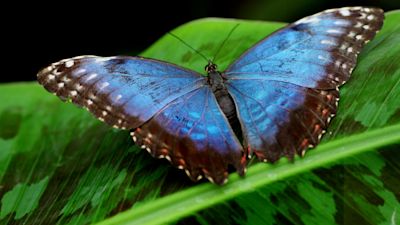150-year-old argument over evolution finally settled by researchers at the University of Essex

Researchers have finally solved an argument that's been rumbling around for 150 years.
The study – published in the journal Communications Biology – explores a controversy between Victorian scientists Charles Darwin and Alfred Russel Wallace.
The two pioneering thinkers were at odds at how butterflies develop their distinctive patterns and colouration.
Cambridge academic Darwin thought males had more variation, because females often chose mates based on male appearance.
Whereas Wallace thought natural selection - survival of the fittest across sexes was the biggest factor in difference.
Now biologists at the University of Essex have used machine learning, a form of artificial intelligence, to finally work out who was right.
Dr Jennifer Hoyal Cuthill, from the School of Life Sciences, said: "Charles Darwin and Alfred Russel Wallace were totally agreed on the importance of survival of the fittest in evolution but they disagreed on the importance of sex and sexual selection.
"Wallace was sceptical of Darwin’s newest theory of sexual selection. He didn’t quite believe that female-made choice in animals birds and butterflies could really affect how males evolved and how they looked."
The research analysed more than 16,000 images of tropical birdwing butterflies in the Natural History Museum's collection, and the results were that both men were partly right.
It found that while males often have more distinct shapes and patterns, both males and females contribute to the overall diversity.
Dr Hoyal Cuthill explained: "[The study] allowed us to see how similar males and females were from different species of Birdwing butterfly.
"We found examples with some groups of species where males were more variable with blue and green and orange colours, different shaped wings, but in other groups it was the females with their subtle variations on speckled brown and white were still more variable than the male males of the species."
Machine Learning
How Machine Learning worked
How Machine Learning worked
Dr Hoyal Cuthill said solving the Darwin Wallace debate would have been impossible without AI.
"If you think about how you would go about measuring something, ask yourself ' how would you compare two butterflies?' What would you even choose to measure? How big they were? Patterns and colouration?
"What machine learning lets us do is take into account all of this variation at once and this would be an impossible task to do by hand but now can be done really quickly with Machine learning"
What is Machine Learning?
What is Machine Learning?
It's a branch of AI. It is the reason TV streamers can recommend show to you, or your phone can provide predictive text.
In essence, as the name suggests, the computer learns things by itself rather than the need for programming.
The computers are provided with a large set of information - in the case of the University of Essex research, thousands of photographs of butterflies.
The computer is given a set of instructions to folllow - in this case looking at cariations in the shape, size, patterning and colouration of butterflies.
The lecturer said it could be just the beginning for advances in the understanding of both evolution and how it could help conserve endangered species.
"This is a really exciting time in evolutionary science, because now for the first time we can use machine learning to measure how visually similar different things are in all the complexity of their shapes, their colours, their patterns and we can test a huge range of theories that have been outstanding since the beginnings of evolutionary theory.
"We can test a huge range of theories that have been outstanding since the beginnings of evolutionary theory."By studying evolution we can understand how things evolved in the past and this is really important.
"The big challenge at the moment is trying to catalogue and understand biodiversity before it disappears and machine learning can be really important in helping us to measure diversity to understand species in order to better protect them."
Want a quick and expert briefing on the biggest news stories? Listen to our latest podcasts to find out What You Need To Know...